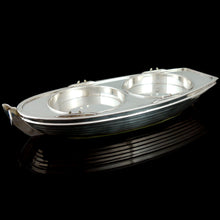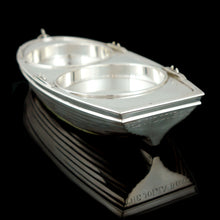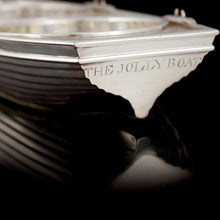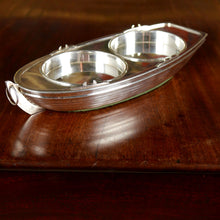Royal Navy - A Georgian Officer’s Jolly Boat Decanter Stand, 1800
Adding product to your cart
Length: 32cm (12.5in)
Silver on copper. A double decanter stand in the form of clinker-built jolly boat, inset with twin circular depressions for decanters, fitted with a rope-ring attachment to the prow. The underside fitted with baize covered base for ease of movement around the dining table. The jolly boat coaster gives a glimpse into the shipboard dining customs of officers in Nelson’s navy. It was customary at the table after pouring wine or spirit from the decanter, to return it to the stand and push it along to the next officer. It is believed that the saying ‘to push the boat out’ has its origins in the custom as the officer paying for the wine was the first to start the jolly boat off round the table.
Jolly boat wine coasters were sometimes supplied with wheeled carriages, supposedly for use ashore. At sea, these were dispensed with giving the flat bottomed decanter stand stability aboard a rolling ship. The term 'jolly boat' has several potential origins. It may originate in the Dutch or Swedish jolle, a term meaning a small bark or boat. Other possibilities include the English term yawl, or the 'gelle-watte', the latter being a term in use in the 16th century to refer to the boat used by the captain for trips to and from shore.
The earliest known jolly boat coasters that can be precisely dated bear the silver hallmark date of 1799 (Dawson, W. R., (1932) ‘The Nelson collection at Lloyd’s’). Of the few examples that are known nearly all are Sheffield plate (silver on copper) and thus unmarked. The National Maritime Museum refers to an example belonging to Captain George Murray RN (d.1819) that can confidently be dated to his period of command of HMS Edgar, 1801-1803. Examples sold by The Armoury include one made for Captain Frederick Maitland RN, who in July 1815 accepted the formal surrender of Emperor Napoleon Bonaparte on board H.M.S. Bellerophon; and a pair made for Captain Henry Blackwood RN, who with Captain Hardy of the Victory was witness to Nelson’s will in the hours before the Battle of Trafalgar.










